What do you think of when you hear “boarding school”? Do you think of jail cells in the basement or child labor performed by 8-year-olds?
Unfortunately, both were very real parts of the Indian Boarding School system.
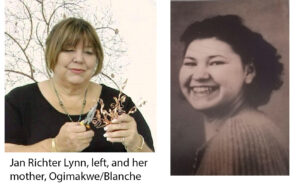 Jan Richter Lynn invites you to walk in the shoes of her mother, Blanche, and aunts Delia and Freda on their journey through the Hayward Indian School, an off-reservation boarding school for Native American children in Sawyer County, Wisconsin.
Jan Richter Lynn invites you to walk in the shoes of her mother, Blanche, and aunts Delia and Freda on their journey through the Hayward Indian School, an off-reservation boarding school for Native American children in Sawyer County, Wisconsin.
Ms. Lynn, an Anishinabeg elder of the Lac Courte Oreille Tribe, asks that we engage her family’s story through a lens of resilience and strength. This is a survivor’s story, filled with grace and courage in addition to moments of terror and years of family separation.
I had the chance to talk with Ms. Lynn in late June 2022, 95 years after her then 6-year-old mother was removed from her family and taken to the Hayward Indian School, where she would live until she was 12. Our collaboration with Ms. Lynn started just one month after the May 2022 release of the Federal Indian Boarding School Initiative Investigative Report quoted below.
This is one family’s story.
— Susan Conwell, Executive Director, Kids Matter Inc.
“My mother’s first memory of removal is a red truck, ” Lynn said. “She was just 6 years old and hadn’t ridden in a truck before. She didn’t have any warning. A red truck pulled up. The red truck was owned by the Bureau of Indian Affairs (BIA) representative called the ‘Farmer.’ The Farmer operated the local store in an area of the reservation called ‘the Reserve.’
My mother and her two sisters were put on the truck and dropped off at the school in Hayward. They didn’t know that they would spend the next six years of their lives away from their family living at the school. Their parents couldn’t prepare the girls because they didn’t know themselves.
“It is so important that people understand what ‘boarding school’ was really like. In 1927, the year my Mom started at the school, it was so overcrowded that many girls shared beds. If you have ever seen a photo of a pre-Depression-era single bed, you will appreciate the level of overcrowding. They were tiny, narrow beds.”
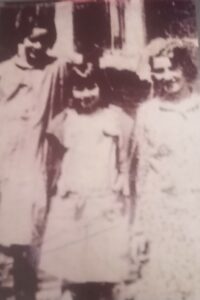
“In some ways, my Mom considered herself fortunate. She went to Hayward with her two older sisters, so she wasn’t alone. Even so, it was scary. It was a large building with many, many children and very few adults. This is the reverse experience of her extended family community, where there were many elders and multiple generations of family members and neighbors who were part of an extended community.”
“There were so many new things to manage at school, from living apart from family at age 6 to the large number of rules.
My Mom didn’t talk about Hayward often, but when she did she talked about the number of rules the children had to learn.
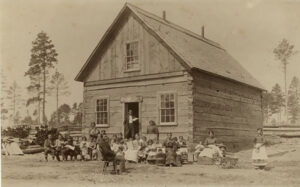
There were bells and whistles to get up, to use the bathroom, and to go to bed. The children had to march everywhere – to bathrooms, to classes, to meals and to bed. The children were banned from speaking their Native language or using any Native words.
All the kids had their heads shaved when they first arrived. Then my Mom and the other girls were allowed to grow their hair into ear-length bobs, while the boys all had short haircuts. Even the little children were lined up to march and have drills. Wake-up times, classes, meals, bathroom breaks, chores and bedtime were on strict schedules. All children had to attend church.
“Mom and her family were already Catholic, as Sister Serilla and Father Gordon were hosting services in Ojibwe already. Mom had both an Ojibwe name and a ‘white name.’ Her Ojibwe name is Ogimakwe meaning ‘high-born lady’ or ‘queen.’ Her white name, Blanche, is on her baptismal certificate and that is the name she used at school. Mom was always so frustrated with her white name because ‘Blanche’ means ‘white.’
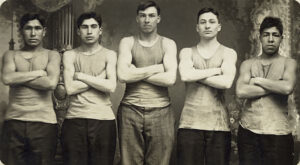
Some children had Native names only, and they were banned from using them. They were given a white name if they didn’t already have one. The children who weren’t Christian had to give up all of their Native-American ceremonies and holidays.
“Mom described having new things like indoor plumbing and showers at the school. Unfortunately, there were only a handful of toilets, in the basement, that were always backing up. There were hundreds of students and just a few toilets.
“The promoters of the boarding schools made a big deal out of ‘civilizing’ kids by giving them indoor plumbing. But people forget that many rural people used outhouses at the time. Less than half of the homes in rural areas had indoor plumbing.” In fact, in 1920 only 1% of U.S. homes had both electricity and indoor plumbing.
“Mom said that some of these modern features were not so great. Even though there were showers, there were all kinds of problems with controlling water temperature. The older kids used to bully the little kids with ‘needles of fire’ or ‘hot needles.’ The older kids would turn on the water as hot as it would go and make the younger children run through when the water was much too hot to stand under.
“The staffing ratios were so poor that older children were given many responsibilities for taking care of the younger children. Some of the older children treated the younger children like servants,” Lynn said. “Mother said that an older girl in charge of her dorm would make young children rub the backs of the older girls all night. Mom always said how lucky she was to have Delia and Freda, who protected her from the worst of this.
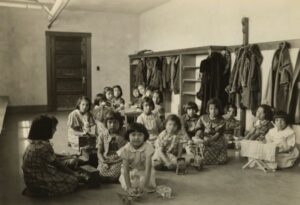
“Due to overcrowding, kids were always getting sick. Illnesses like chickenpox spread through the school like wildfire. It was up to the older children to take care of the younger children. When children died of illnesses, the children’s bodies were returned to their families to be buried, as the reservation was only 12 miles away. Hayward is one of the few Native American Boarding Schools that did not have its own graveyard.”
A 1923 inspection by a Chief Medical Supervisor found that boys at Hayward were not provided with toothbrushes, and reported that the boys did not use toothbrushes. Girls were provided toothbrushes, but no toothpaste or powder.(6)
“It is odd to me now as an adult that the schools were supposed to address issues of overcrowding in Native American homes, while conditions were often worse at school,” Lynn said. “Yes, my mother had an outhouse in 1927 before going to Hayward – and so did over half the county!
It was more sanitary than the constantly overflooding flush toilets in the basement of the school.
“When the Hayward school closed in 1934, there were 12 to 15 staff to teach, feed and supervise 1,300 students. Young students like my mother were mixed in with students who were 20 years old or older, who were only there to learn a trade or provide labor. This was not a good environment for young children.”
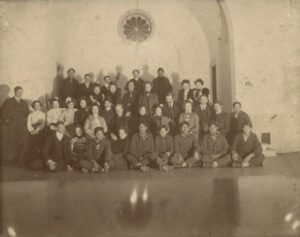
In 1923 there were 826 students at Hayward classified as adults, and 483 minors.
Some of the biggest health issues at the Hayward Indian Boarding School were caused by overcrowding and poor sanitation. Several reports on the Hayward kitchen described the unsanitary conditions, and that access to hot water was limited to once or twice a week.
When the Spanish flu came to Wisconsin in 1918 and 1919, the death rate at the Hayward Indian School was 10 times the death rate of the general population in Wisconsin.(7)
“Mom talked about overcrowding, and the reports by education officials back her up,” said Lynn. Hayward School superintendents repeatedly wrote to the Department of Interior to request a gymnasium or winter play or exercise area to improve the health of the children. One inspector wrote: “We cannot possibly justify the continuance of a school in this northern latitude which lacks the provisions necessary to keep the children healthy.” This school was the only “non-reservation school in the north without one.”
Another superintendent noted the unfairness of providing facilities for children in the south, but not in the north: “I am compelled to question the wisdom of their action and doubt their real interest in the welfare of Indian children.”(8)
In 1925, just before Blanche attended Hayward, an inspector stated that a gymnasium and additional school room were desperately needed and “if most of these things cannot be done the school should be closed.”(9)
“One of my Mom’s strongest memories is of a safety issue at the school that led to her having multiple broken bones,” Lynn said.
“The commissary or dining hall was a separate wood building. The building had an outside staircase. External staircases did not have the safety features they do today. All of the kids had to line up on this external staircase for meals. When my mother was walking up to the top of the second story, the wind caught the screen door and it pushed her through the railing. She was stuck hanging onto the second- floor railing. The groundskeeper came running to try to catch her, but she fell from the second story onto concrete.
She had a compound fracture in her wrist and other broken bones. The matron took her by train to a hospital in Madison the next day to get her bones set. My then 8-year-old Mom spent 8 months alone in a hospital in Madison recovering. She had her arm in traction for four of those months. Then she was sent back to Hayward. I’m sure it was very painful and lonely, but my Mom said that she enjoyed the attention in the hospital. Her parents were notified of the broken bones, but they couldn’t afford the train ride to visit her in Madison.
“Mom’s broken hand stayed smaller throughout her life.”
Girls in the school were taught domestic skills like sewing, cooking, baking, washing, mending and ironing. There are many reports about boarding schools that describe how the boys were taught farming and dairy work. The Hayward school had 250 acres in production, led by instructor farmers, with boys providing most of the labor.(10)
The labor of the students was vital to keeping the doors of the school open. Labor was segregated by gender. The boys were growing the food, while the girls were doing the cooking and feeding the students, along with sewing and cleaning up.
The Interior Department tracked how many items the girls sewed. In 1922, girls at Hayward made 629 dresses, 566 sheets, 1080 towels, 141 aprons, 124 bloomers, and various other articles of clothing.(11)
This is in addition to doing much of the cooking and baking that fed the students.
Many boarding schools hired the students out as labor to local farmers. This process was called “outing” or sending children “out” to work.
“The official records of Hayward say that the school didn’t hire the kids out as labor to farmers,” said Lynn. “But my Mom always told us a story of someone coming to the dorms in June and gathering her and her sisters together to go stay with a farmer in Grantsburg to work on a farm. She spent the summer picking green beans. Mom told me that she and her sisters picked green beans for six weeks at a time. The school received the payment.
“Other summers my mother was allowed to return home. During her summers off, she worked as domestic help at a nearby resort. Mom helped at a nearby resort for two summers – she was 10 when she started providing domestic help.
“Mom remembers white visitors to the school giving her 50 cents to take a photo. Visitors wanted to take a photo with a Native American child. Although there are certainly ethical issues in this kind of practice, Mom was happy to have the 50 cents as she often wasn’t paid for other labor like sewing or baking.
“Mom’s favorite memories of Hayward were the Christmas pageants. As I mentioned, Mom and her sisters were already Christian, and they enjoyed acting in the pageants and having Christmas treats. One year, Mom’s big Christmas present was a bar of Palmolive soap. She tried to save it as a special treasure. She stored it in her locker, and would take it out to smell the fragrance as a treat. Another student stole it from her locker. She was so disappointed.”
Overcrowding was a constant problem at Hayward. By 1920, enrollment had reached 296 children, while the actual capacity of the dormitories without overcrowding was 184 children. With only a few teachers, it wasn’t possible to provide adequate schooling – even with only part days of school. Older students were relied on to help keep order and to teach skills like sewing and baking.
Some of the older students were kind but others were not. “My aunt Delia was horribly abused by an older student.
When she reported the abuse, the older student disappeared from school. But the damage was done.”
“Running away was part of life at Hayward,” Lynn said. “My mother was so young that she couldn’t run away, but many of the older boys ran back to their homes.
“Jimmy Pipe Mustache was a family friend of ours. As an adult, he told stories about the school. One time he and three friends ran off into the woods to snare a rabbit. They stayed out all night, cooking the rabbit and eating it and speaking Ojibwe.
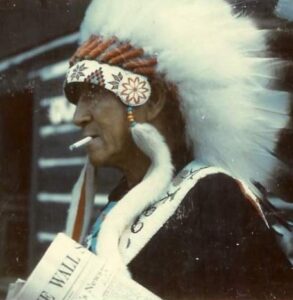
“When they were returned to the school, Jimmy and his friends were locked up in that jail cell in the basement for three days. They were only allowed bread and water for those three days….
“Jimmy said that all of the students knew they would be punished for running away or speaking their language. He said that they just had to do it. They didn’t want to give up their customs and language. They needed to get out of those military uniforms. And they didn’t want to go hungry either! We missed rabbit and deer. None of the traditional foods were served at the school.
“Jimmy also told us that boys who ran away would be chained to their beds. When I was old enough to check, I learned that this is true.
“One of the ways the school tried to prevent kids from leaving, and prevent them from continuing to use Native customs, was to make it hard for the students to get to the woods. All of the woods near the school were clear-cut. This meant that the older kids had to go far out into the woods to find a deer – or a rabbit like Jimmy and his friends.”
Lynn remembers seeing the jail cell in the basement of the school during a visit there in the 1960s, when she was 17. At that time the building was not in use, and the basement was partially flooded. Later, two of the buildings were moved away from the school complex and moved onto new foundations down the road. They were converted to apartment buildings. They took the buildings, but not the cells in the basement.
“My mother remembers ‘Matron’ well, because she went on the train to take my mother to the hospital in Madison. Matron later came back to bring my Mom back to Hayward. This was a special circumstance. Most kids did not get to know the Matron so well or take a train anywhere.
“My aunt Freda was the only one to graduate from the boarding school that year. She didn’t have a dress to wear for the graduation ceremony – only the school uniform. Three of the teachers pooled resources and bought her a dress to wear, along with new shoes and a ribbon for her hair. She was very proud to go on the stage at school and get her diploma.
“Most kids were simply sent back to the reservation and didn’t graduate.” (Nationally, only about half of Indian Boarding School students graduated, according the the U.S. Education Department.)
“My mother was sent home at age 12 when the school closed,” Lynn said. “She went to Whitefish for a year, where she advanced several grades. Then she attended high school in LaFarge in Vernon County. Her white grandfather paid an aunt to take her in and provided extra money to feed and clothe her. Mom always said what a big difference it made for her future that she got to attend a normal public high school and graduate from a normal public high school. She believes this made all the difference for her later life opportunities.
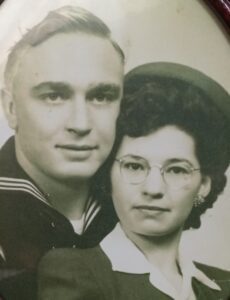
“My Dad was born in Namekogan which is about 30 miles from Hayward.
After Mom graduated from high school, she went to Cicero, Illinois to become a nanny. My Dad was in the Navy at the Great Lakes Naval Training Center. They got married in 1941 before my father was deployed.
“My father and his brother were both deployed to Pearl Harbor. Both of them were on the USS Maryland when the bombs fell at Pearl Harbor. “
“While my Dad was in service, my Mom worked at a photography studio. They stayed in the Chicago area after the war until they retired. After they retired, they returned to Hayward and built a house on Smith Lake.
“Jimmy Pipe Mustache was at Hayward with my Mom and her sisters. He was a rebel in school to the teachers, but a helper to the kids. Kids looked up to him. He was one of the older kids who helped the other kids preserve Native American ways in their hearts. Jimmy became a Third Degree Midewiwin. Jimmy was well known in the Great Lakes area. He really promoted tourism in Hayward. He was one of the founders, along with Tony Wise, in developing tourism in the Hayward area. He helped develop the Hayward History Village.
Jimmy would bring out relatives and they would have Pow Wows, dancing, and sell beads. He walked everywhere. He walked the three miles from Smith Lake to town and back in his late 70s and refused to live in senior housing on the Rez. Jimmy said he wanted to die in the home of a traditional Indian. He passed in the home of Jerry Smith, an up and coming Midewiwin, when he was 87 years old. Jimmy was a well-known story-teller on the Rez. Oral history and tradition are so very important.”
“After World War II, there were so many people living in refugee and displaced persons camps in Europe. In 1949, my parents took in six Polish family members from a displaced persons camp in Poland. I always thought that my Mom’s experience being separated from her family and my Dad’s experience in the war really gave them empathy for others.”
Jan Richter Lynn is a Native American copper artist and the proprietor of Copper Cattail Chimes and The Copper Artist. Her work has been exhibited at the National Museum of the American Indian on the Mall in Washington D.C. and the website of the Department of the Interior’s Indian Arts and Crafts Board.
Lynn was a licensed optician for 45 years. She is a recipient of grants from the Ford Foundation, the National Endowment for the Arts and the National Museum of the American Indian.
She has eight grandchildren and one great-grandchild. She wants to share this story with them, and to share her family story through the generations.
The Federal Indian Boarding School movement was a key US strategy for “civilizing” Native Americans by removing them from Native lands and separating families from their children. Army officer and founder of the Carlisle Indian Industrial School, Richard Pratt, summarized this philosophy as: “Kill the Indian … save the man.”
The Federal Indian Boarding School movement is a central experience for Native Americans, but is rarely included in U.S. history books. For example, many high school students learn about the surrender of Apache leader Geronimo and removal of Chiricahua Apache families from present-day Arizona to Florida as US prisoners of war. They were imprisoned in Florida for 23 years. Very few people learn that once Apache families reached Florida, the surviving Apache children were forcibly removed and shipped by train to the Carlisle Industrial School in Pennsylvania.
Conditions were often appalling in the Indian boarding schools. Due to overcrowding, disease, and sometimes abuse, many Apache children never returned. One-fourth of the known Carlisle gravesites are Apache children, according to the federal Indian Boarding School Initiative Investigative Report.
Even people who know about the Federal Indian Boarding School movement do not know of the extent of Indian boarding schools in Wisconsin. Jan Richter Lynn hopes to change that by sharing her mother’s story.
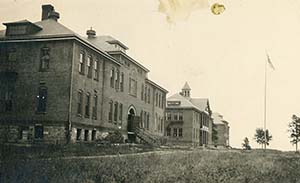
The Hayward Indian School in Sawyer County, WI opened in September, 1901, 22 years after the first Indian Boarding school opened in Carlisle, Pennsylvania. The school opened “under very unfavorable conditions. Clothing, subsistence, and equipments for the plant had not reached the school.…”(1)
It was so chaotic during the first years of the Hayward Indian School that the first superintendent of the school resigned within the first year.(2) Numerous U.S. Department of the Interior reports sited problems of overcrowding, underfunding, unsafe conditions and inadequate staff among the problems at the Hayward Indian School.
The school closed in 1934, in part due to economic shortages of the Great Depression and in part due to the overall failure of the boarding school movement. Over 33 years, the school housed thousands of Native-American children from reservations in Wisconsin and Minnesota, though the vast majority of students were from the Lac Courte Oreille reservation in Sawyer County, Wisconsin. Hayward was one of three US.-operated boarding schools in Wisconsin. There were also three day schools, and three Indian boarding schools contracted by the United States that were run by religious organizations.
Some of the biggest health issues at the Hayward Indian Boarding School were caused by overcrowding and poor sanitation. Several reports on the Hayward kitchen described the unsanitary conditions, and that access to hot water was limited.
When the Spanish flu came to Wisconsin in 1918 and 1919, the death rate at the Hayward Indian School was ten times the death rate of the general population in Wisconsin.(3)
“Mom talked about overcrowding, and the reports by education officials back her up,” said Lynn. Hayward School superintendents repeatedly wrote to the Department of the Interior to request a gymnasium or winter play or exercise area to improve the health of the children. One inspector wrote: “We cannot possibly justify the continuance of a school in this northern latitude which lacks the provisions necessary to keep the children healthy. This school was the only “nonreservation school in the north without one.” Another superintendent noted the unfairness of providing facilities for children in the south, but not in the north: “I am compelled to question the wisdom of their action and doubt their real interest in the welfare of Indian children. “(4)
In 1925, just before Blanche attended Hayward, an inspector stated that a gymnasium and additional school room were desperately needed and “if most of these things cannot be done the school should be closed.”(5)